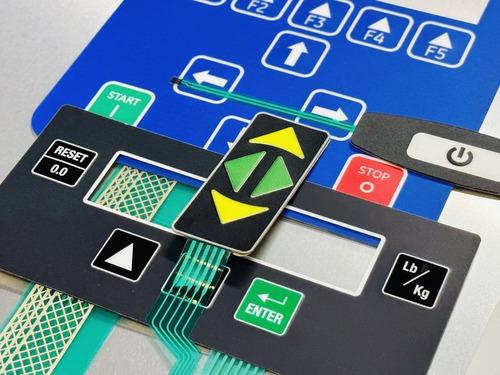Find Out Exactly How Membrane Switches Assistance Touch-Sensitive Applications with Precision
Find Out Exactly How Membrane Switches Assistance Touch-Sensitive Applications with Precision
Blog Article
Discover the Future of Control Interfaces: Why Membrane Layer Switches Are Getting Appeal
As industries progressively focus on straightforward and effective control user interfaces, membrane layer buttons are arising as an engaging option that combines functionality with design flexibility. With the rise of clever modern technology and sustainability problems, the technologies and capacities bordering membrane switches over warrant more detailed assessment.
Recognizing Membrane Layer Switches
Membrane switches are integral parts in modern-day digital devices, working as user interfaces between equipments and customers. These switches contain multiple layers, generally including a visuals overlay, a spacer layer, and a circuit layer. When a customer presses a switch on the overlay, the top layer reaches the circuit layer, finishing a circuit and sending out a signal to the gadget. This easy yet efficient device enables smooth communication with technology.

Resilience is one more crucial attribute, as membrane layer buttons can be made to stand up to ecological factors such as moisture, dust, and chemicals. This durability makes them optimal for applications in rough conditions. Overall, recognizing the structure and feature of membrane layer switches is essential for valuing their function in the evolution of interface in today's technology-driven globe.
Key Benefits of Membrane Buttons
Using a variety of advantages, membrane buttons have become a recommended option in numerous applications (Membrane Switches). Among the primary benefits is their compact layout, allowing manufacturers to maximize area in devices without endangering performance. Membrane layer buttons are lightweight, which is especially valuable in portable digital devices

In addition, these buttons offer superb resilience. Created from adaptable materials, they are resistant to dirt, wetness, and a selection of environmental elements, making them appropriate for rough conditions. This sturdiness commonly converts right into a longer lifespan compared to conventional mechanical switches.
Additionally, membrane layer switches over enable smooth assimilation of graphics and symbols, providing aesthetic flexibility and enhancing user experience. Personalization choices are substantial, making it possible for brand names to produce special user interfaces that line up with their product identity.
One more trick benefit is their ease of cleaning and upkeep. The level surface area of membrane layer switches avoids the accumulation of dirt and grime, making them perfect for hygienic atmospheres. Finally, membrane layer buttons are cost-effective, as they can be produced in high quantities at reduced prices, making them obtainable for a wide variety of industries. These elements collectively add to their raising appeal in modern-day control user interfaces.
Applications Throughout Industries

A myriad of markets are significantly adopting membrane switches due to their flexibility and performance. These regulate user interfaces are specifically widespread in the auto sector, where they are used in dashboards and infotainment systems, offering a smooth and easy to use user interface. In the clinical area, membrane layer switches facilitate the operation of diagnostic equipment and patient monitoring systems, guaranteeing dependability and simplicity of use in essential situations.
Additionally, the consumer electronics market gain from membrane switches in devices such as microwaves and remotes, enabling structured layout and enhanced sturdiness. Membrane Switches. The aerospace market also utilizes membrane switches in cockpit controls, where space restrictions require small and efficient style solutions
Furthermore, the commercial field uses membrane buttons in machinery control board, supplying strength versus severe environments and making sure functional efficiency. Retail atmospheres have embraced membrane layer switches in point-of-sale systems, boosting individual interaction while preserving visual charm.
Style Patterns in Membrane Layer Switches
Developing together with technical advancements, style trends in membrane switches are progressively concentrated on improving individual experience and aesthetic allure. Modern membrane layer switches are being created for simplicity and intuitive usage, permitting customers to browse interfaces easily. This shift in the direction of user-centric style emphasizes tactile responses, ensuring that customers receive instant confirmation of their activities.
Furthermore, customizable graphics and colors are ending up being standard features in membrane switch designs. This adaptability permits suppliers to produce customized user interfaces that straighten with branding and particular customer needs. The incorporation of backlighting is one more prominent fad, as it not just enhances exposure in low-light conditions but likewise includes an aesthetically striking component to the total layout.
Furthermore, the fad towards lightweight and slim materials is acquiring grip, permitting for sleeker designs that can perfectly integrate into numerous applications. This change not only enhances appearances but additionally adds to the overall performance and resilience of the switches. Eco-friendly materials are increasingly being utilized, reflecting a wider activity in the direction of sustainability in item design. These design trends jointly highlight the expanding value of combining form and function in the advancement of membrane layer buttons, eventually enriching the customer helpful hints experience.
Future Overview for Control Interfaces
The future of control user interfaces is poised for considerable transformation as emerging modern technologies proceed to reshape individual communications throughout various gadgets. The combination of innovative go to my blog materials, such as versatile electronic devices and conductive inks, will enhance the convenience and capability of membrane switches, making them progressively versatile to a variety of applications. In addition, the rise of the Internet of Things (IoT) will drive demand for more user-friendly, straightforward user interfaces that can flawlessly incorporate with clever tools.
As expert system and device discovering progress, regulate user interfaces will likely include even more tailored attributes, permitting customers to connect with tools in ways that are tailored to their routines and choices (Membrane Switches). This change towards user-centric style will position membrane buttons as a principal on the market, specifically in fields like medical care, auto, and customer electronics
Furthermore, the press for sustainability will motivate manufacturers to check out environmentally friendly products and production techniques, making certain that the future of control interfaces lines up with ecological considerations. Generally, as modern technology continues to breakthrough, membrane switches will certainly come to be increasingly advanced, leading the way for ingenious control options that boost user experience and operational effectiveness throughout varied industries.
Conclusion
In final thought, the enhancing adoption of membrane switches over highlights their value in the development of control interfaces. As user-friendly user interfaces end up being vital in the context of IoT and AI developments, membrane layer buttons are positioned to play a crucial duty.
As markets increasingly focus on reliable and easy to use control interfaces, membrane layer switches are arising as a compelling option that combines capability with design adaptability.Longevity is one more key function, as membrane switches can be designed to withstand ecological elements such as dampness, dust, and chemicals.Progressing alongside technical advancements, style fads in membrane switches are significantly focused discover this on improving customer experience and aesthetic charm. Modern membrane layer buttons are being developed for simpleness and intuitive use, permitting users to navigate user interfaces easily. These design patterns jointly emphasize the growing significance of incorporating form and function in the advancement of membrane layer buttons, ultimately enhancing the individual experience.
Report this page